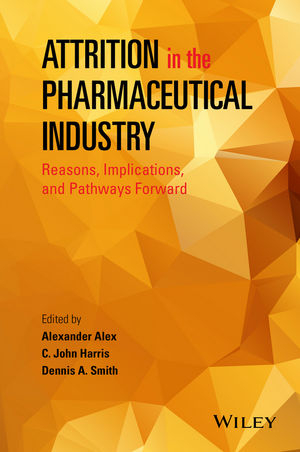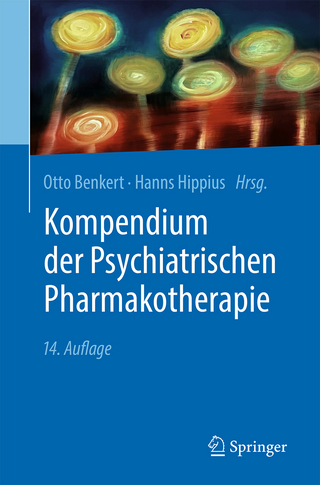
Attrition in the Pharmaceutical Industry
John Wiley & Sons Inc (Verlag)
978-1-118-67967-8 (ISBN)
Takes a comprehensive and holistic approach to the problems and potential solutions to drug compound attrition
Tackles a problem that adds billions of dollars to drug development programs and health care costs
Guides discovery and development scientists through R&D stages, teaching requirements and reasons why drugs can fail
Discusses potential ways forward utilizing new approaches and opportunities to reduce attrition
Alexander Alex, Dr. rer. nat., is director of Evenor Consulting and has over 20 years' experience as consultant and as director and research fellow in drug discovery in the pharmaceutical industry. C. John Harris, PhD, is the director of cjh Consultants and has a successful track record in drug discovery, research management, small company fund-raising and start-ups. Dennis A. Smith, PhD, is an independent consultant with a long track record in drug discovery and development with an emphasis on metabolism and safety. He has published four books, including Pharmacokinetics and Metabolism in Drug Design (1st and 2nd editions) and Reactive Drug Metabolites published by Wiley.
Contributors xiii
Introduction 1
Alexander Alex C. John Harris and Dennis A. Smith
References 4
1 Attrition in Drug Discovery and Development 5
Scott Boyer Clive Brealey and Andrew M. Davis
1.1 “The Graph” 5
1.2 The Sources of Attrition 7
1.3 Phase II Attrition 9
1.3.1 Target Engagement 11
1.3.2 Clinical Trial Design 11
1.4 Phase III Attrition 12
1.4.1 Safety Attrition in Phase III 14
1.5 Regulation and Attrition 17
1.6 Attrition in Phase IV 19
1.7 First in Class Best in Class and the Role of the Payer 32
1.8 Portfolio Attrition 34
1.9 “Avoiding” Attrition 36
1.9.1 Drug Combinations and New Formulations 36
1.9.2 Biologics versus Small Molecules 37
1.9.3 Small-Molecule Compound Quality 38
1.10 Good Attrition versus Bad Attrition 39
1.11 Summary 40
References 42
2 Compound Attrition at the Preclinical Phase 46
Cornelis E.C.A. Hop
2.1 Introduction: Attrition in Drug Discovery and Development 46
2.2 Target Identification HTS and Lead Optimization 50
2.3 Resurgence of Covalent Inhibitors 55
2.4 In Silico Models to Enhance Lead Optimization 56
2.5 Structure-Based and Property-Based Compound Design in Lead Optimization 59
2.5.1 Risks Associated with Operating in Nondrug-Like Space 62
2.6 Attrition Due to ADME Reasons 64
2.6.1 Metabolism Bioactivation and Attrition 68
2.6.2 PK/PD Modeling in Drug Discovery to Reduce Attrition 69
2.6.3 Human PK Prediction Uncertainties 70
2.7 Attrition Due to Toxicity Reasons 72
2.8 Corporate Culture and Nonscientific Reasons for Attrition 75
2.9 Summary 76
References 76
3 Attrition in Phase I 83
Dennis A. Smith and Thomas A. Baillie
3.1 Introduction 83
3.2 Attrition in Phase I Studies and Paucity of Published Information 84
3.3 Drug Attrition in not FIH Phase I Studies 85
3.4 Attrition in FIH Studies Due to PK 86
3.4.1 Attrition due to Pharmacogenetic Factors 88
3.5 Attenuation of PK failure 90
3.5.1 Preclinical Methods (In Vivo) 90
3.5.2 Preclinical Methods (In Vitro) 91
3.5.3 Phase 0 Microdose Studies in Humans 92
3.5.4 Responding to Unfavorable PK Characteristics 94
3.6 Phase I Oncology Studies 95
3.7 Toleration and Attrition in Phase I Studies 97
3.7.1 Improving the Hepatic Toleration of Compounds 98
3.7.2 Rare Severe Toxicity in Phase I Studies 98
3.8 Target Occupancy and Go/No]Go Decisions to Phase II Start 99
3.9 Conclusions 102
References 102
4 Compound Attrition in Phase II/III 106
Alexander Alex C. John Harris Wilma W. Keighley and Dennis A. Smith
4.1 Introduction 106
4.2 Attrition Rates: How Have they Changed? 107
4.3 Why do Drugs Fail in Phase II/III? Lack of Efficacy or Marginal Efficacy Leading to Likely Commercial
Failure 108
4.4 Toxicity 111
4.5 Organizational Culture 112
4.6 Case Studies for Phase II/III Attrition 112
4.6.1 Torcetrapib 112
4.6.2 Dalcetrapib 113
4.6.3 Onartuzumab 114
4.6.4 Bapineuzumab 115
4.6.5 Gantenerumab 115
4.6.6 Solanezumab 116
4.6.7 Pomaglumetad Methionil (LY]2140023) 116
4.6.8 Dimebon (Latrepirdine) 117
4.6.9 BMS]986094 117
4.6.10 TC]5214 (S]Mecamylamine) 118
4.6.11 Olaparib 118
4.6.12 Tenidap 119
4.6.13 NNC0109]0012 (RA) 120
4.6.14 Omapatrilat 120
4.6.15 Ximelagatran 121
4.7 Summary and Conclusions 122
References 123
5 Postmarketing Attrition 128
Dennis A. Smith
5.1 Introduction 128
5.2 On-Target Pharmacology-Flawed Mechanism 130
5.2.1 Alosetron 130
5.2.2 Cerivastatin 130
5.2.3 Tegaserod 133
5.3 Off-Target Pharmacology Known Receptor: An Issue of Selectivity 135
5.3.1 Fenfluramine and Dexfenfluramine 135
5.3.2 Rapacuronium 136
5.3.3 Astemizole Cisapride Grepafloxacin and Thioridazine 138
5.4 Off-Target Pharmacology Unknown Receptor: Idiosyncratic Toxicology 142
5.4.1 Benoxaprofen 142
5.4.2 Bromfenac 142
5.4.3 Nomifensine 143
5.4.4 Pemoline 144
5.4.5 Remoxipride 144
5.4.6 Temafloxacin 145
5.4.7 Tienilic acid 145
5.4.8 Troglitazone 146
5.4.9 Tolcapone 146
5.4.10 Trovafloxacin 147
5.4.11 Valdecoxib 148
5.4.12 Zomepirac 148
5.5 Conclusions 150
References 151
6 Influence of the Regulatory Environment on Attrition 158
Robert T. Clay
6.1 Introduction 158
6.1.1 How the Regulatory Environment has Changed Over the Last Two Decades 159
6.1.2 Past and Current Regulatory Attitude to Risk Analysis and Risk Management 161
6.2 Discussion 162
6.2.1 What Stops Market Approval? 162
6.2.2 Impact of Black Box Warnings 166
6.2.3 Importance and Impact of Pharmacovigilance 167
6.2.4 Prospects of Market Withdrawals for New Drugs 168
6.2.5 What are the Challenges for the Industry Given the Current Regulatory Environment? 173
6.2.6 Future Challenges for Both Regulators and the Pharmaceutical Industry 174
6.3 Conclusion 175
References 176
7 Experimental Screening Strategies to Reduce Attrition Risk 180
Marie-Claire Peakman Matthew Troutman Rosalia Gonzales and Anne Schmidt
7.1 Introduction 180
7.2 Screening Strategies in Hit Identification 183
7.2.1 Screening Strategies and Biology Space 183
7.2.2 Screening Strategies and Chemical Space 187
7.2.3 High-Throughput Screening Technologies 191
7.2.4 Future Directions for High-Throughput Screening 194
7.3 Screening Strategies in Hit Validation and Lead Optimization 194
7.4 Screening Strategies for Optimizing PK and Safety 197
7.4.1 High-Throughput Optimization of PK/ADME Profiles 198
7.4.2 Early Safety Profiling 202
7.4.3 Future Directions for ADME and Safety in Lead Optimization 204
7.5 Summary 205
References 206
8 Medicinal Chemistry Strategies to Prevent Compound Attrition 215
J. Richard Morphy
8.1 Introduction 215
8.2 Picking the Right Target 216
8.3 Finding Starting Compounds 216
8.4 Compound Optimization 218
8.4.1 Drug-Like Compounds 218
8.4.2 Structure-Based Drug Design 219
8.4.3 The Thermodynamics and Kinetics of Compound Optimization 220
8.4.4 PK 220
8.4.5 Toxicity 222
8.5 Summary 225
References 226
9 Influence of Phenotypic and Target]Based Screening Strategies on Compound Attrition and Project Choice 229
Andrew Bell Wolfgang Fecke and Christine Williams
9.1 Drug Discovery Approaches: A Historical Perspective 229
9.1.1 Phenotypic Screening 229
9.1.2 Target-Based Screening 230
9.1.3 Recent Changes in Drug Discovery Approaches 231
9.2 Current Phenotypic Screens 233
9.2.1 Definition of Phenotypic Screening 233
9.2.2 Recent Anti-infective Projects 233
9.2.3 Recent CNS Projects 235
9.3 Current Targeted Screening 237
9.3.1 Definition of Targeted Screening 237
9.3.2 Recent Anti-infective Projects 237
9.3.3 Recent CNS Projects 239
9.4 Potential Attrition Factors 241
9.4.1 Technical Doability and Hit Identification 241
9.4.2 Compound SAR and Properties 246
9.4.3 Safety 248
9.4.4 Translation to the Clinic 250
9.5 Summary and Future Directions 252
9.5.1 Summary of Impact of Current Approaches 252
9.5.2 Future Directions 254
9.5.3 Conclusion 255
References 255
10 In Silico Approaches to Address Compound Attrition 264
Peter Gedeck Christian Kramer and Richard Lewis
10.1 In Silico Models Help to Alleviate the Process of Finding Both Safe and Efficacious Drugs 264
10.2 Use of In Silico Approaches to Reduce Attrition Risk at the Discovery Stage 265
10.3 Ligand-Based and Structure-Based Models 265
10.4 Data Quality 268
10.5 Predicting Model Errors 270
10.6 Molecular Properties and their Impact on Attrition 272
10.7 Modeling of ADME Properties and their Impact of Reducing Attrition in the Last Two Decades 275
10.8 Approaches to Modeling of Tox 276
10.9 Modeling PK and PD and Dose Prediction 276
10.10 Novel In Silico Approaches to Reduce Attrition Risk 278
10.11 Conclusions 280
References 280
11 Current and Future Strategies for Improving Drug Discovery Efficiency 287
Peter Mbugua Njogu and Kelly Chibale
11.1 General Introduction 287
11.2 Scope 288
11.3 Neglected Diseases 289
11.3.1 Introduction 289
11.3.2 Control of NTDs 290
11.3.3 Drug Discovery Potential of Neglected Diseases 290
11.4 Precompetitive Drug Discovery 292
11.4.1 Introduction 292
11.4.2 Virtual Discovery Organizations 293
11.4.3 Collaborations with Academic Laboratories 295
11.4.4 CoE and Incubators 296
11.4.5 Screening Data and Compound File Sharing 297
11.5 Exploitation of Genomics 297
11.5.1 Introduction 297
11.5.2 Target Identification and Validation 298
11.5.3 Target-Based Drug Discovery 298
11.5.4 Phenotypic Whole-Cell Screening 301
11.5.5 Individualized Therapy and Therapies for Special Patient Populations 302
11.6 Outsourcing Strategies 304
11.6.1 Introduction 304
11.6.2 Research Contracting in Drug Discovery 305
11.7 Multitarget Drug Design and Discovery 305
11.7.1 Introduction 305
11.7.2 Rationale for Multitargeted Drugs 306
11.7.3 Designed Multitarget Compounds for Neglected Diseases 307
11.8 Drug Repositioning and Repurposing 315
11.8.1 Introduction 315
11.8.2 Cell Biology Approach 317
11.8.3 Exploitation of Genome Information 318
11.8.4 Compound Screening Studies 318
11.8.5 Exploitation of Coinfection Drug Efficacy 318
11.8.6 In Silico Computational Technologies 319
11.9 Future Outlook 319
References 319
12 Impact of Investment Strategies Organizational Structure and Corporate Environment on Attrition and Future Investment Strategies to Reduce Attrition 329
Geoff Lawton
12.1 Attrition 329
12.2 Costs 331
12.2.1 The Costs of Creating a New Medicine 331
12.2.2 The Costs of Not Creating a New Medicine 332
12.3 Investment Strategies 334
12.3.1 RoI 334
12.3.2 Investment in a Portfolio of R&D Projects 335
12.3.3 Asset-Centered Investment 335
12.3.4 Sources of Funds 336
12.4 Business Models 337
12.4.1 FIPCO 337
12.4.2 Fully Integrated Pharmaceutical Network (FIPNET) 338
12.4.3 Venture-Funded Biotech 339
12.4.4 Fee-for-Service CRO 339
12.4.5 Hybrids 339
12.4.6 Academic Institute 340
12.4.7 Social Enterprise 341
12.5 Portfolio Management 341
12.5.1 Portfolio Construction 341
12.5.2 Project Progression 343
12.5.3 The Risk Transition Point 343
12.6 People 344
12.6.1 Motivation 344
12.6.2 Culture and Leadership 344
12.6.3 Sustainability 344
12.7 Future 345
12.7.1 Business Structures 345
12.7.2 Skilled Practitioners 347
12.7.3 Partnerships 348
12.7.4 A Personal View of the Future 349
References 351
Index 353
| Erscheint lt. Verlag | 2.12.2015 |
|---|---|
| Verlagsort | New York |
| Sprache | englisch |
| Maße | 158 x 236 mm |
| Gewicht | 658 g |
| Themenwelt | Medizin / Pharmazie ► Medizinische Fachgebiete ► Pharmakologie / Pharmakotherapie |
| Naturwissenschaften ► Chemie | |
| Technik | |
| ISBN-10 | 1-118-67967-9 / 1118679679 |
| ISBN-13 | 978-1-118-67967-8 / 9781118679678 |
| Zustand | Neuware |
| Informationen gemäß Produktsicherheitsverordnung (GPSR) | |
| Haben Sie eine Frage zum Produkt? |
aus dem Bereich


